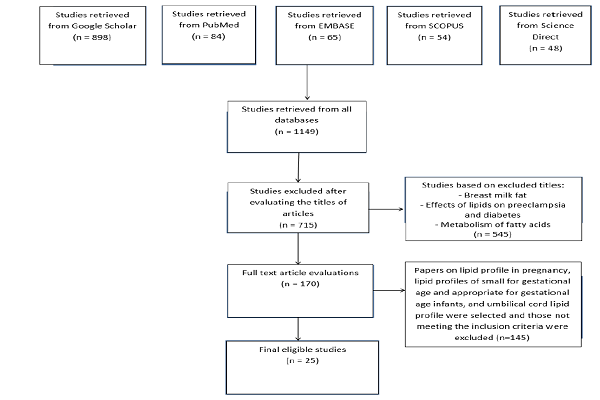The relationship between lipid profiles in pregnancy and preterm delivery: a systematic review
DOI:
https://doi.org/10.15419/bmrat.v5i8.468Keywords:
Cholesterol, HDL, LDL, Lipid profile, Preterm delivery, TriglyceridesAbstract
Background: High-density lipoprotein (HDL), low-density lipoprotein (LDL), triglyceride (TG), and total cholesterol (TC) are associated with maternal hormonal changes which can lead to pregnancy complications. High lipid levels during pregnancy may be accompanied by an increased risk of spontaneous preterm labor. The purpose of this review was to determine the relationship between lipid profiles in pregnancy and preterm delivery.
Methods: A systematic search was performed in PubMed, EMBASE, Web of Science, Scopus, and Science Direct databases to find cross-sectional, case-control, and cohort studies on the associations between lipid profiles in pregnancy and preterm delivery. The search results were limited to papers published during 2000-2018. The quality of the selected studies was assessed based on the Strengthening the Reporting of Observational Studies in Epidemiology (STROBE) checklist. Finally, a total of 25 eligible high-quality papers were reviewed.
Results: A high maternal TG level in the first trimester of pregnancy was identified as a significant risk factor for preterm delivery. Low TG, HDL-cholesterol (HDL-C) and LDL-cholesterol (LDL-C) levels were uniquely associated with an increased risk of preterm delivery. High TC, TG, and LDL-C levels increased the risk of spontaneous preterm labor. A further association was found between high TG and TC levels and an elevated risk of preterm labor before 34 weeks of gestation. The risk of preterm labor before 34 weeks and during the 34th-37th weeks of gestation increased with increasing TG and TC levels. Moreover, overweight women who had a delivery before 34 weeks exhibited significant increases in TC and LDL concentrations during early pregnancy.
Conclusion: Lipid metabolism undergoes complicated changes in pregnancy. Lipid levels (LDL, HDL, TC, and TG) above or below the normal range during pregnancy increase the risk of preterm delivery. Considering the significance of maternal lipid metabolism in the incidence of preterm delivery, lipid profile screening in early pregnancy can largely contribute to the prevention of preterm delivery. Further studies are warranted to meticulously examine the effects of lipid profile on preterm delivery.

Downloads
Published
Issue
Section
License
Copyright The Author(s) 2017. This article is published with open access by BioMedPress. This article is distributed under the terms of the Creative Commons Attribution License (CC-BY 4.0) which permits any use, distribution, and reproduction in any medium, provided the original author(s) and the source are credited.
